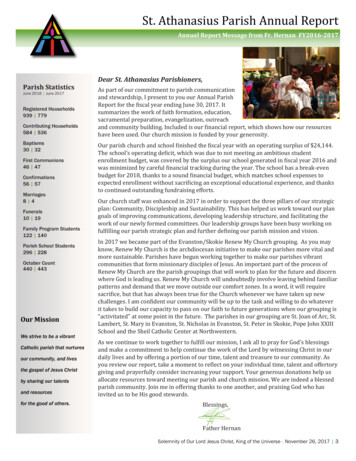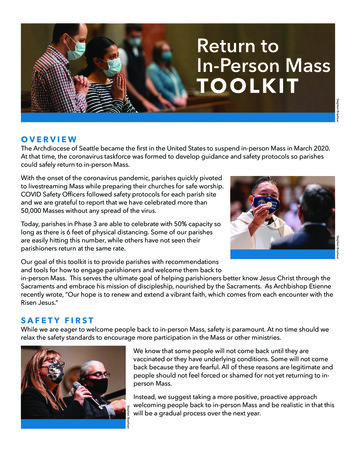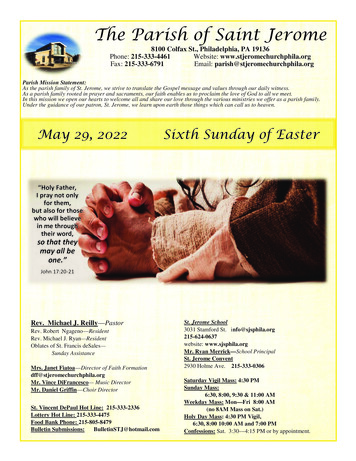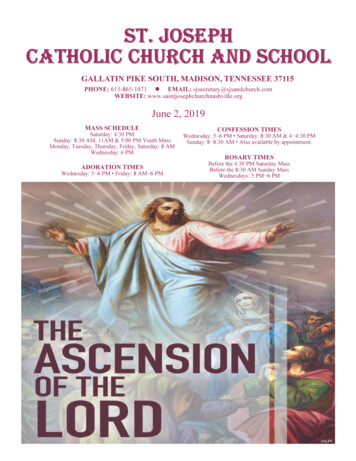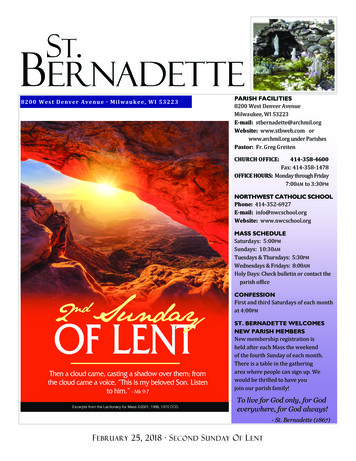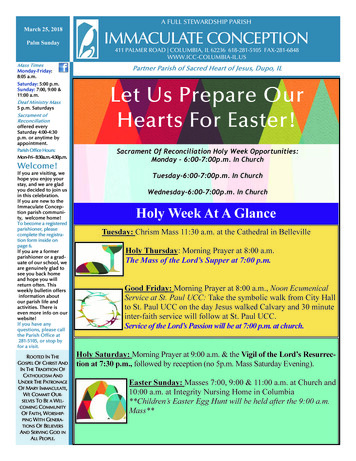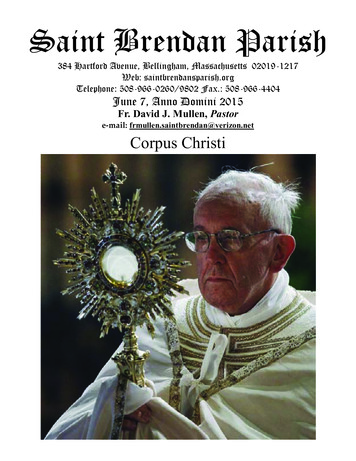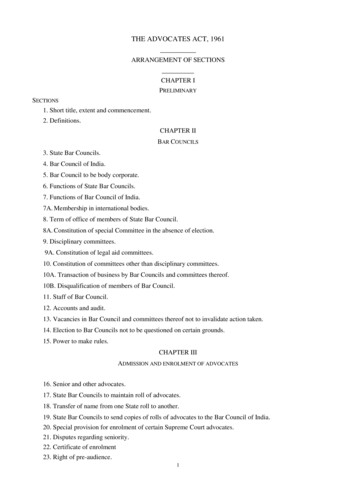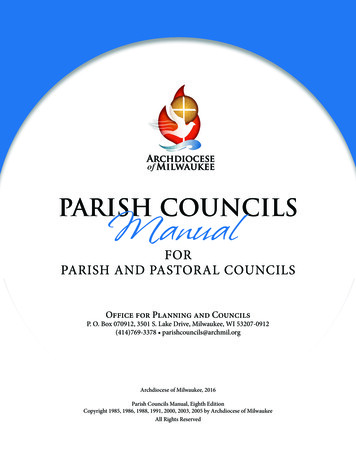
Transcription
Parish Councils ManualPARISH COUNCILSManualFORPARISH AND PASTORAL COUNCILSOffice for Planning and CouncilsP. O. Box 070912, 3501 S. Lake Drive, Milwaukee, WI 53207-0912(414)769-3378 parishcouncils@archmil.orgArchdiocese of Milwaukee, 2016Parish Councils Manual, Eighth EditionCopyright 1985, 1986, 1988, 1991, 2000, 2003, 2005 by Archdiocese of MilwaukeeAll Rights Reserved
Chapterof ContentsParishTableCouncilsManualFOR PARISH USE:PAGE1 Mission Statement/Parish Organizational Chart62 Pastoral Plan/Master Site Plan73 Council Norms/Appendices84 Roster of Members95 Finance Council Agendas/Notes106 Pastoral Council Agendas/Minutes11PASTORAL COUNCIL COMMISSION/COMMITTEE DESCRIPTIONS:7 Parish as People: A Community of Discipleship and Evangelization128 Parish as Mission: To Teach, Sanctify, Serve, Unify199 Parish as Structure: Foster Pastoral Activity and Administer Goods27COUNCIL BASICS:10 Finance Council: Administering of Goods3911 Pastoral Council: Fostering Pastoral Activity45BEST PRACTICES:12 Planning the Council Year5213 Preparing for Effective Meetings5614 Discerning New LeadersFOR CONTINUING FORMATION:15 Training and Resources6371Parish Finance and Pastoral Councils Manual I Archdiocese of Milwaukee1
July 1, 2015Dear Parish Leaders,As of this date, all parishes in the Archdiocese of Milwaukee will be using the new norms for pastoral andfinance councils which I approved in 2012. These norms call for a commitment and partnership of pastors,deacons, pastoral staffs, councils, commissions and committees to carry out the mission of the Church.The Second Vatican Council, in Lumen Gentium: Dogmatic Constitution on the Church, article 33, remindsus that through Baptism all members of the Church are called to holiness and to share responsibility for themission of the Church. All of the Popes since the Council have affirmed this call and responsibility.The Parish Councils Manual is a key resource for all parish leaders and especially those serving on pastoraland finance councils. I pray that you will find in these pages the information and support you will need:To deepen the understanding of your response to the call to serve as a council member; To guide the way for councils to work together effectively; To understand the mission of Jesus and the Church as well as to enthusiastically see that it iscarried out; To invite others to become more involved in the mission activity of the Church; and To become a more committed and dedicated disciple of Christ.Service on a council is both an honor and a challenge. You have been called and chosen to serve by peoplewho have recognized your faithfulness and leadership skills. That is an honor not to be taken lightly. Butwith the honor comes responsibility and that is your challenge. Your challenge is to help your parish carryout the mission of Jesus Christ and the Church more effectively than before.With assurance of prayers, I amSincerely yours in Christ,Most Reverend Jerome E. ListeckiArchbishop of MilwaukeeParish Finance and Pastoral Councils Manual I Archdiocese of Milwaukee3
Parish Councils Manual— ABOUT THIS MANUAL —Each parish and cluster of parishes is unique. Yet all parishes, wherever they are, have the same mission. Thatmission is to continue the work of Christ within the local area. Parishes do this by calling people to holiness andsupporting them in their Christian life through the proclamation of the Gospel, prayer and worship, reaching outto those who are hurting or in need, as well as building up the community and expanding the Reign of God.The Parish Councils Manual is a resource manual for parish finance and pastoral councils. Its primary purpose isto promote effective ministry by those selected to serve on these councils and to strengthen their collaborationwith the pastor, parishioners, commissions or committees, and the parish staff. This manual spells out the roleand responsibilities of council members and helps them examine and sharpen their skills for leadership. The roleand responsibilities of the pastor described throughout the book also apply to priests who serve as administratorsand those assigned by the archbishop as parish directors.The canon law quotations in the manual are used with permission from the Code of Canon Law, Latin-EnglishEdition (Washington, Canon Law Society of America, 1998).The Role of Commissions/Committees in the ParishTO:You, the Council member For listening and responding to a call to council ministry and saying, “Yes.” For giving your time and talent so generously as a leader in your parish.TO:Our Bishops Whose inspiring leadership has shepherded us in holiness Who urge us to embrace the future with faith, hope and love Who challenge us to live faith-fullyTO:Gerald M. Schaefer, Marilyn Bowman, Don Lozier, Marliss Rogers, Fr. Michael Hammer,Noreen Welte and all whose dedicated efforts since 1970 have led us to this edition.Our hope is that you find the Parish Councils Manual to be a valuable and useful resource for you personally, foryour council, and for the Church in Southeastern Wisconsin.Mark Kemmeter, DirectorOffice for Planning and CouncilsParish Finance and Pastoral Councils Manual I Archdiocese of Milwaukee4
Parish Councils Manual— HOW THE MANUAL IS ORGANIZED —TABS 1 THRU 6 - Parish Documents and Meeting MaterialsThis section is to be used by council members at each meeting. This is where each parish’s council documentsshould be inserted: Mission Statement and the Parish Organizational ChartPastoral Plan and Master Site PlanCouncil Norms and AppendicesRosters of MembersFinance Council Agendas and NotesPastoral Council Agendas and MinutesTABS 7 THRU 9 – Council Member FormationThis section contains general formation for each council member on the purpose and organization of the parish aspeople, mission and structure.TABS 10 AND 11 – Understanding Each Council and Their RolesThis section provides information about the finance and pastoral councils and their roles in assisting with theadministration of goods and fostering pastoral activity.TABS 12 THRU 15 – Resources for Best PracticesThis section focuses on the practicalities and essentials for effective council activity, meetings, and the selection of newmembers as well as resources for council and member use.Parish Finance and Pastoral Councils Manual I Archdiocese of Milwaukee5
ATEMENT/PARISHORGANIZATIONALCHARTArchdiocese of Milwaukee - Mission StatementProclaim Christ and Make Disciplesthrough theSacramental Life of the Church.Parish Finance and Pastoral Councils Manual I Archdiocese of Milwaukee6
LAN/MASTER SITEPLANParish Finance and Pastoral Councils Manual I Archdiocese of Milwaukee7
RMS/APPENDICESParish Finance and Pastoral Councils Manual I Archdiocese of Milwaukee8
ParishCouncilsManualParishCouncilsManual4ROSTER OF MEMBERSParish Finance and Pastoral Councils Manual I Archdiocese of Milwaukee9
ParishCouncilsManualParishCouncilsManual5FINANCE COUNCILAGENDAS/NOTESParish Finance and Pastoral Councils Manual I Archdiocese of Milwaukee10
ParishCouncilsManualParishCouncilsManual6PASTORAL COUNCILAGENDAS/MINUTESParish Finance and Pastoral Councils Manual I Archdiocese of Milwaukee11
ParishCouncilsManualParishCouncilsManual7PARISH AS PEOPLE:A COMMUNITY OFDISCIPLESHIP ANDEVANGELIZATIONParish Finance and Pastoral Councils Manual I Archdiocese of Milwaukee12
Parish Councils Manual - Parish as People: A Community of Discipleship and EvangelizationCouncil nominees and members usually possess a good working knowledge of their parishes. They know whatthe parish does, how it operates, and who the key leaders are. Serving on a council also requires the memberto understand what a parish can and should be. This three-part formation section on parish is based onthe USCCB’s (United States Conference of Catholic Bishops) document, The Parish: A People, A Mission, AStructure, which was published in 1998.In the document, the bishops propose a vision of parish life that encourages respect for diversity yet urges thateach parish continually strive “to become more fully a people of God, sharing the mission of Christ anddeveloping the structure necessary for supporting its community life and carrying out its mission.”— A COMMUNITY OF DISCIPLESHIP AND EVANGELIZATION,CENTERED IN JESUS AND THE EUCHARIST —The late Avery Cardinal Dulles may be best known for his book, Models of the Church (1974). For decades, councilmembers in the Archdiocese of Milwaukee and throughout the country became familiar with the Church modelsof “institution,” “herald,” “sacrament,” “servant,” and “community.” Dulles, though, continued looking for a modelwhich could harmonize the differences of each model and become like an overarching model which included all. In1986, he presented “the Church as a community of disciples” model. True discipleship leads to mission activity.All subsequent editions of Models of the Church include the additional material on “community of disciples.”On the most basic level, a parish is a community of people who follow Jesus. A parish is a people who are centeredin the Eucharist which Jesus established to make them one and to nourish them on their journey of discipleship.As a people, we are sent to proclaim the Good News of Jesus to others and to live out our faith throughout theweek.Let’s take a look at the diagram on the next page which not only illustrates this model but shows how both councilsand commissions are at the heart of Church activity.Parish Finance and Pastoral Councils Manual I Archdiocese of Milwaukee13
Parish Councils Manual - Parish as People: A Community of Discipleship and Evangelization— ORGANIZATION FOR MISSION —Community of Discipleship & Evangelizationer Pastoral ActivityF o stPastoral pFigure AAdmFinanceFinanceCouncilCouncili n ist ra ti o n o f G o o dsIn the center of the diagram is the Sunday Eucharist. The Eucharist is at the center of our life in Christ. The SundayEucharist is when most of the members of the parish gather together. The Eucharist sends us to carry out the missionof Jesus Christ and His Church. The four arms of the cross show us the four areas of mission: worship, formation andevangelization, human concerns and stewardship. This is what the parish does: carries out the mission.There is a wider circle around the cross which represents the roles of both the finance and pastoral councils. Thepastoral council’s role is “to foster pastoral or mission activity.” The finance council’s role is “to administer or managethe parish goods.” The goods of the parish are collected in order to carry out the mission. How well and to what extentthe mission can be carried out relies on the goods of the parish. Both councils have distinct but interrelated roles.Both councils help to organize the community into one of discipleship and evangelization. Jesus calls people tofollow him as His disciples. Discipleship means living a life of growth in faith, virtuous living, and service to others.Discipleship further means that we are called to invite others to be disciples just as we were invited. This means thata parish community cannot just be focused on its members. Our call includes reaching out to all people in the areawhich our parish serves and evangelize or proclaim the Good News of Jesus to them especially through our actions.The councils are assisted in their roles to carry out and support the mission by commissions. These commissionsserve as task groups which insure that the ministry activity in each of the four areas of mission is effective and properlysupported. Without the work of these commissions, the councils would be unable to provide a full and effective rangeof ministry.Parish Finance and Pastoral Councils Manual I Archdiocese of Milwaukee14
Parish Councils Manual - Parish as People: A Community of Discipleship and Evangelization— “HOW THE CHURCH DEVELOPEDAND HOW WE COME TO EXPERIENCE JESUS” —Council members need to gain insight into the people who make up their communities. As you can see from theprevious section, Jesus and the Eucharist are at the center of every parish. Every parish has to provide parishionerswith opportunities to experience the person of Jesus Christ. Without this experience of profound faith, people maybecome members of the parish but not necessarily disciples.In order to understand what happens when people are born into a parish, we should understand how the Churchdeveloped. This is a schema developed by the late Fr. Andrew Greeley, a priest sociologist, who was able to blendtheology and the social sciences to give us a deeper insight into the challenges every parish faces.FormedCommunity to ShareExperience andDeepen FaithWrote Down StoriesAbout Jesus andLetters to theCommunitiesDevelopedPractices andTraditionsSet up Structuresand InstitutionsProfound Encounterwith the Personof JesusEarlyChurchThe Experience of JesusUsEncounter theStructures andInstitutionProfoundEncounter withthe Person ofJesusFormedCommunity andBelongingBecome Familiarwith the Storiesand WritingsParish Finance and Pastoral Councils Manual I Archdiocese of MilwaukeeImmersed in thePractices andTraditions15
Parish Councils Manual - Parish as People: A Community of Discipleship and EvangelizationWe can look to the Gospels, Acts of the Apostles, letters, and Church history and read how the early churchresponded to the profound encounter with the person of Jesus. This was a faith experience so powerful and lifechanging that it had to be shared with others.The early Christians formed communities. These communities provided others with whom they could sharetheir faith experiences, understand them, and deepen their faith. Faith is a relationship which draws us intodeeper relationship with God and others. Faith by its very nature must be shared. The early Christians recognizedthis and further realized they were part of a universal community of believers.As time went on, the community came to realize that the stories and teachings which the apostles and othersproclaimed needed to be written down and collected. They realized that future generations of believers couldcome to encounter Jesus in these writings.Over the centuries, practices and traditions were adopted which had served other generations of Christians ontheir journeys of faith. They were passed on as the wisdom of those who had gone before us.As the Church spread throughout the world, structures and institutions were developed to support and sustainthe mission of the Church. All were intended to support and lead future generations of believers to a personalencounter with Jesus.Now that we have an understanding of how the Church developed, we need to understand how Christians todaybegin their experience of Jesus. Most believers today begin the encounter with Jesus in reverse order. We areborn into families of believers and our experience begins not with the profound encounter with the person of Jesusbut an encounter with the structure and institution of the Church. Many of our earliest memories are about thechurch building we attended, the stained glass we viewed, the flickering candles and vigil lights, perhaps the smell offlowers and incense.The journey of faith for those baptized as infants or children further involves learning the traditions, writings andteachings. Some believers never move beyond these experiences of Jesus in His Church. They may view the churchas a building or as a collection of traditions from the past or some writings and teachings which have a certainapplication to my life. Without a sense of community and especially without a personal experience of Jesus, theseCatholics are vulnerable to stop practicing the faith or to seek other paths.Parishes and councils, then, must be aware that the parish should invite people into a deeper relationship withJesus and the community of disciples as well as provide opportunities for this to happen. As part of the annualevaluation of parish mission activity in a parish, this is one of the most important activities for councils to monitorand keep in focus.Parish Finance and Pastoral Councils Manual I Archdiocese of Milwaukee16
Parish Councils Manual - Parish as People: A Community of Discipleship and Evangelization— THE CALL TO DISCIPLESHIP AND HOLINESS —Jesus calls all of us to follow Him. We respond by becoming disciples and living lives of witness and service. The callto follow also includes a call to holiness. The call to holiness means that being a disciple involves living a life whichis in touch with how the Holy Spirit is leading and guiding us. The beliefs and practices which describe how thislife in the Spirit is lived out make up what is called a “spirituality.” Most Catholics are familiar with this term as it isused with religious orders. For example, Franciscan spirituality is characterized by the charism or gift of poverty aspracticed by St. Francis. Dominican spirituality is rooted in the gift of preaching and teaching. Every religious orderand society has a particular spirituality.The Second Vatican Council made it very clear that all the baptized are called to holiness. All of us are called todevelop a spiritual life which supports and sustains our life of discipleship. How do we develop a spirituality?Some Catholics practice the spirituality of a particular religious order and society. Many Catholics either cobblevarious spiritual practices together or do not realize that they have a spiritual life or even need one.Council members need to understand the spiritual or inner life of those in the community. As Christians andCatholics, we begin by realizing that there is a shared spirituality which all members of the community can shareand a personal spirituality which each person needs to develop. The diagram box on the following page shouldhelp us with this understanding of a shared and a personal spirituality.Area of MissionAspects of a Shared Spirituality withOther Followers of JesusAspects of My PersonalSpiritualityWordParticipate in faith sharing andenrichment opportunities to grow in faithRead the scriptures and view otherspiritual materials to deepen my faithand invite others to encounter JesusWorshipAttend Mass faithfully and participate inthe sacramental life of the ChurchPray and reflect on my life as partof my daily routineServiceAssist in local, national and world effortsto serve the poor and those in needWitness to my faith at home,work, and playShare time, talent and treasure inresponse to the call to discipleshipLive a life of gratitude,sharing and simplicityStewardshipParish Finance and Pastoral Councils Manual I Archdiocese of Milwaukee17
Parish Councils Manual - Parish as People: A Community of Discipleship and EvangelizationEvery spirituality contains certain basic elements. The basic elements are: Beliefs about God, Jesus, the Spirit, the Church, what the Church teaches – a spirituality is rooted in livingout what we believe. Participation in the sacramental life of the Church, particularly the Eucharist – a spirituality is rooted inpraise and thanks to God and in prayer with the community of believers. Living a life of service, motivated by love for others – a spirituality must include taking care of ourselvesand all those we call our neighbors. Involvement in and commitment to the community of believers – a spirituality must include someconnection to the faith community.The left column describes the four areas of the Church’s mission which will be discussed in greater detail in thenext chapter. Those four areas of mission correspond to the basic elements of every spirituality. Moving to themiddle column, “Shared Spirituality,” you can readily see that every member of a vibrant parish has opportunitiesto participate in every aspect of the spirituality which is shared by all members of vibrant communities. Growth infaith and growth in spirituality are lifelong processes.Making our shared spirituality our only spirituality can lead to the “Sunday only” school of thinking. There ismuch more to living out our faith than just on Sundays. We need a personal spirituality which includes theshared spirituality but which guides us throughout the other days of the week and throughout our lives. Thelast column, “Personal Spirituality,” challenges us to personalize the Gospel and to live out on a daily basis what webelieve and practice in the community.The first thing to understand about parish and, for that matter, the Church, is it is PEOPLE. The Church andthe parish are the people of God. Jesus came to bring life and salvation to people not buildings or a parking lot orthe parish office. Everything we do in the parish should be for people.Parish Finance and Pastoral Councils Manual I Archdiocese of Milwaukee18
ParishCouncilsManualParishCouncilsManual8PARISH AS MISSION:TO TEACH, SANCTIFY,SERVE, UNIFYParish Finance and Pastoral Councils Manual I Archdiocese of Milwaukee19
Parish Councils Manual - Parish as Mission: To Teach, Sanctify, Serve, Unify— THE MISSION OF THE CHURCH:TEACH, SANCTIFY, SERVE, UNIFY —“Go, make disciples of all nations, baptize them in the name of the Father and of the Son and of the Holy Spirit. Teachthem to carry out everything I have commanded you.” (Matthew 28:19-20)Jesus invited and called people to follow him. The response to following Jesus is to do as the verses above suggest:“carry out everything I have commanded you.” As the people of God, we have been given a mission. It is the missionof Jesus. We are to continue the work which Jesus began. To know what the mission is all about, we must look to“what Jesus did.”What did Jesus do?The Gospels tells us in four different versions all about the activity of Jesus. The diagram below illustrates howthis activity can be understood in four distinct ways.THE MISSION OF JESUSProclaimedthe WORDBuiltCommunityJesus ChristIn His TimePrayed andWorshippedServed andHealed Thosein NeedFigure DStarting at the top, Jesus proclaimed the Word of God. Proceeding clockwise, Jesus prayed and worshipped, servedand healed those in need, and built community. Each section below provides key passages from the Gospels whichprovide insight and understanding of what Jesus taught, how he prayed, healed, and built community.Parish Finance and Pastoral Councils Manual I Archdiocese of Milwaukee20
Parish Councils Manual - Parish as Mission: To Teach, Sanctify, Serve, Unify“PROCLAIMED THE GOOD NEWS”Jesus proclaimed a message of love and forgiveness through his teaching and use of parables. Look up thesepassages in the Gospels to gain deeper insight and understanding of his teaching mission.o The Beatitudeso Jesus’ authority is questionedo The “Great Discourse”o I am the way, the truth and the lifeo Love one another as I have lovedo Woman at the wello The Greatest Commandmento The ten leperso Sower and the seedo Lamp under a basketo Good Samaritano Mustard Seed; leaven (yeast)o Widow’s Miteo Lilies of the fieldso Suffered, died and rose from the deadMatthew 5 and Luke 4:18Luke 20Luke 6:17John 14:6John 5:12John 4:1-42Matthew 22:34-40Luke 17:11Luke 8:4Matthew 5:15; Mark 4:21; Luke 8:16Luke 10:25-37Matthew 13:31; Mark 4:30; Luke 13:18Luke 21:1Matthew 6:25-33 and Luke 12:22Matthew 26-28; Mark 14-16; Luke 22-24;John 12-21“PRAYED AND RITUALLY CELEBRATED”The Gospels show us that Jesus was a person of prayer and ritual celebration. Find and reflect upon thesepassages in the Gospels to gain insight about the importance of prayer and ritual in Jesus’ life.o Jesus prayingo Jesus teaching others to prayo Jesus praying in the gardeno Wedding at Canao Multiplication of the Loaveso Last Suppero The Emmaus travelersMatthew 14:23, 11:27-31, 26:36-46Luke 9:18, 6:12, 9:18, 9:29, 22:39-46Mark 1:37, 3:21, 6:41, 14:32-42John 17Luke 11:5-13, 11:2ff, 18:1;Matthew 6:9-15, 18:19-20John 14:13-14, 16:23, 26-27Matthew 26:36-44; Mark 14:32-41;Luke 22:39-46Matthew 14:13-21; Mark 6:30-44;Luke 9:10ff; John 6:1-13Matthew 26:26-30; Mark 14:22-25;Luke 22:19ffLuke 24:13ffParish Finance and Pastoral Councils Manual I Archdiocese of Milwaukee21
Parish Councils Manual - Parish as Mission: To Teach, Sanctify, Serve, Unify“HEALED AND SERVED”The message of Jesus was one of forgiveness and new life. It was evident in Jesus’ many cures, signs and actions.Read the passages below to see and come to know the many ways Jesus touched and transformed people’s lives.ooooooooMan with an unclean spiritThe leper and the paralyzed manThe Centurion’s servantCalming of the seaThe person possessed by a demonJairus’ daughterThe sinful womanWashing of the Apostles’ feetLuke 4:33ffLuke 5:12ffLuke 7Matthew 8:23-27; Mark 4:35-41; Luke 8:22ffMatthew 8:28-34; Mark 5:1-20; Luke 8:26ffMark 5:21-43; Matthew 9:18-26; Luke 8:40-56Luke 7:36-50John 13:1-17“CALLED INTO AND FORMED COMMUNITY”The very nature of following Jesus means to become part of a community of believers. The followers are tocontinue his mission and it takes a community, a church to carry it out. Look at the passages below to gain insightabout how Jesus called people into community and formed community.o First discipleso Levi, the tax collectoro Selection of the twelveo Mission of the twelveo The seventy-twoMatthew 4:18-22; Mark 1:16-20; Luke 5:1-11Luke 5:27ffLuke 6:12ffLuke 9:1-6; Matthew 10:1-8, 14;Mark 3:13-16, 6:7-13Luke 10:1-20“THE MISSION OF JESUS IS THE MISSION OF THE CHURCH”All that Jesus did has been entrusted to his followers – the Church. As you can see in the chart below, the activityof Jesus continued faithfully in the Acts of the Apostles, in the early Church, through the centuries right up to whatis taking place in your parish now.What Jesus DidActs of the Apostles2:42-45Early ChurchWhat Your Parish DoesProclaimed theGood News“devoted themselves to theteaching of the apostles”Kerygma messageTeachesPrayed andCelebrated“to the breaking of the breadand to the prayers”Leitourgia liturgySanctifiesParish Finance and Pastoral Councils Manual I Archdiocese of Milwaukee22
Parish Councils Manual - Parish as Mission: To Teach, Sanctify, Serve, UnifyHealed and Served“sell their property andpossessions and dividethem among all”Diakonia serviceServesBuilt Community“communal life, had allthings together”Koinonia fellowshipUnifiesThis chart shows clearly how the mission of the Church can be clearly linked through the ages back to Jesus, butwe can also appreciate how the understanding of mission is continually changing. Look carefully at the section from the Acts of the Apostles which is an early description of community life. We have many teachers andteachings in addition to the apostles because of nearly two thousand years of apostolic activity. Many of us wouldbalk at the idea of selling all our property and possessions and dividing them among all. How would we be caredfor in retirement? Even if we are not prepared to sell everything we have, we are called to heal and serve thosespiritually and physically in need.Even the breaking of the bread has a certain element of change. Unknown peoples at the time of the early churchare now “breaking bread” and praying in languages that were unheard then. Think of the music that we sing atMass or the sound systems which enable us to hear the Word clearly proclaimed. The mission is constantly interacting with people and cultures. As the speed of cultural change increases, our understanding of how to carryout mission effectively will also need to change.Archdiocese of Milwaukee - Mission StatementTo proclaim the Gospel of Jesus Christthrough his saving death and resurrectionby calling, forming and sending disciplesto go and make new disciples.As a people, we are calledto encounter Jesusthrough the Sacramental Life of the Church.Parish Finance and Pastoral Councils Manual I Archdiocese of Milwaukee23
Parish Councils Manual - Parish as Mission: To Teach, Sanctify, Serve, Unify— PARISH MISSION STATEMENTS —There was a time in the Archdiocese of Milwaukee when all parishes were required to develop a mission statementand to have the statement reviewed by the councils’ office. The rationale was that for a parish to carry out themission effectively the mission had to be articulated and written down. From a theological perspective, letting eachparish define mission can lead to congregationalism – each parish doing its own thing. One parish may say, “we areprimarily about good liturgy here.” Another parish may determine that “human concerns and social justice is ourfocus.” A careful look at the mission of Jesus and the mission of the Church indicates that all areas of mission areessential. None should be overlooked or minimized.In organizing the Church around the world, canon or church law refers to “the local church.” Most readers willthink that phrase is a reference to “parish.” In reality, the reference to “local church” is the diocese. Catholicism isnot congregational. Catholicism is connected, united, and collaborative. It makes sense that, as part of the localchurch, every parish and groupings of parishes should follow the mission statement of the diocese. The diocesearticulates this local vision in an understandable way so that all parishes work together on pastoral activity.Some parishes and groupings of parishes have spent many hours developing a personalized statement of mission.If that statement is still providing inspiration and direction, then by all means continue to use it. Councils areprobably best served though by having a clear understanding of the common mission of Jesus and the Churchwhich we all share and direct their energies to carrying out that mission more effectively.— ORGANIZING MISSION ACTIVITY —The design of pastoral and finance councils is based on fostering and supporting pastoral activity. Everythingthat councils sh
The late Avery Cardinal Dulles may be best known for his book, Models of the Church (1974). For decades, council members in the Archdiocese of Milwaukee and throughout the country became familiar with the Church models of "institution," "herald," "sacrament," "servant," and "community." Dulles, though, continued looking for .


